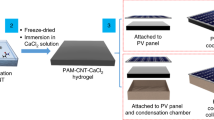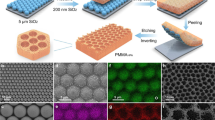Abstract
The sequestration of atmospheric CO2 through plant photosynthesis helps to mitigate climate change while providing other ecological benefits. However, heat and drought stress can limit plant growth and thus the mitigation potential of vegetation, particularly in drylands. Here we present a photosynthetically active radiative cooling film that decreases the ambient air temperature, minimizes the level of water evaporation and increases photosynthesis in dryland plants. This film comprises a photonic crystal layer sandwiched between polydimethylsiloxane and antifogging polyacrylamide hydrogel layers. The polydimethylsiloxane layer, featuring high mid-infrared emissivity (92% for wavelengths of 2.5–20 μm), enables maximal radiative cooling, the photonic crystal permits the selective transmission of photosynthetically active sunlight (71% for wavelengths of 0.4–0.5 μm and 77% for wavelengths of 0.6–0.7 μm) to boost photosynthesis and the polyacrylamide layer prevents the shading effect, thereby supporting plant growth. Field experiments indicated that our film decreases the air temperature by 1.9–4.6 °C and the level of water evaporation by 2.1–31.9%, consequently increasing the biomass yield of plants by 20–370%. According to our assessment, global application of the film on dryland plants could result in an approximately 40% increase in carbon sink compared with the case without the film (2.26 ± 1.43 PgC yr−1). This work highlights the development of next-generation technologies that can address the water–food–energy nexus of climate change.
This is a preview of subscription content, access via your institution
Access options
Access Nature and 54 other Nature Portfolio journals
Get Nature+, our best-value online-access subscription
$29.99 / 30 days
cancel any time
Subscribe to this journal
Receive 12 digital issues and online access to articles
$119.00 per year
only $9.92 per issue
Buy this article
- Purchase on Springer Link
- Instant access to full article PDF
Prices may be subject to local taxes which are calculated during checkout




Similar content being viewed by others
Data availability
All data are available in the main text and Supplementary Information. Source data are provided with this paper.
References
Fargione, J. E. et al. Natural climate solutions for the United States. Sci. Adv. 4, eaat1869 (2018).
Lewis, S. L., Wheeler, C. E., Mitchard, E. T. & Koch, A. Regenerate natural forests to store carbon. Nature 568, 25–28 (2019).
Field, C. B. & Mach, K. J. Rightsizing carbon dioxide removal. Science 356, 706–707 (2017).
Seddon, N. Harnessing the potential of nature-based solutions for mitigating and adapting to climate change. Science 376, 1410–1416 (2022).
Bonan, G. B. Forests and climate change: forcings, feedbacks, and the climate benefits of forests. Science 320, 1444–1449 (2008).
Patriarca, C. et al. Trees, Forests and Land Use in Drylands: The First Global Assessment (Food and Agriculture Organization of the United Nations, 2019); https://www.fs.usda.gov/rm/pubs_journals/2019/rmrs_2019_patriarca_c001.pdf
Flanagan, L. B., Wever, L. A. & Carlson, P. J. Seasonal and interannual variation in carbon dioxide exchange and carbon balance in a northern temperate grassland. Glob. Change Biol. 8, 599–615 (2002).
Ahlström, A. et al. The dominant role of semi-arid ecosystems in the trend and variability of the land CO2 sink. Science 348, 895–899 (2015).
Beer, C. et al. Terrestrial gross carbon dioxide uptake: global distribution and covariation with climate. Science 329, 834–838 (2010).
Wang, L. et al. Dryland productivity under a changing climate. Nat. Clim. Change 12, 981–994 (2022).
Qubaja, R., Grünzweig, J. M., Rotenberg, E. & Yakir, D. Evidence for large carbon sink and long residence time in semiarid forests based on 15 year flux and inventory records. Glob. Change Biol. 26, 1626–1637 (2020).
The Future of Cooling (International Energy Agency, 2018); https://www.iea.org/reports/the-future-of-cooling
McLinden, M. O., Seeton, C. J. & Pearson, A. New refrigerants and system configurations for vapor-compression refrigeration. Science 370, 791–796 (2020).
Ganguly, A. & Ghosh, S. A review of ventilation and cooling technologies in agricultural greenhouse application. Iran. J. Energy Environ. 2, 32–46 (2011).
Sethi, V. & Sharma, S. Survey of cooling technologies for worldwide agricultural greenhouse applications. Sol. Energy 81, 1447–1459 (2007).
Abdel-Ghany, A. M. et al. Covering materials incorporating radiation-preventing techniques to meet greenhouse cooling challenges in arid regions: a review. Sci. World J. 2012, 906360 (2012).
Schaaf, C. B. et al. First operational BRDF, albedo nadir reflectance products from MODIS. Remote Sens. Environ. 83, 135–148 (2002).
Rohatyn, S., Yakir, D., Rotenberg, E. & Carmel, Y. Limited climate change mitigation potential through forestation of the vast dryland regions. Science 377, 1436–1439 (2022).
Rephaeli, E., Raman, A. & Fan, S. Ultrabroadband photonic structures to achieve high-performance daytime radiative cooling. Nano Lett. 13, 1457–1461 (2013).
Raman, A. P., Anoma, M. A., Zhu, L., Rephaeli, E. & Fan, S. Passive radiative cooling below ambient air temperature under direct sunlight. Nature 515, 540–544 (2014).
Shi, N. N. et al. Keeping cool: enhanced optical reflection and radiative heat dissipation in Saharan silver ants. Science 349, 298–301 (2015).
Hsu, P.-C. et al. Radiative human body cooling by nanoporous polyethylene textile. Science 353, 1019–1023 (2016).
Zhai, Y. et al. Scalable-manufactured randomized glass-polymer hybrid metamaterial for daytime radiative cooling. Science 355, 1062–1066 (2017).
Mandal, J. et al. Hierarchically porous polymer coatings for highly efficient passive daytime radiative cooling. Science 362, 315–319 (2018).
Li, T. et al. A radiative cooling structural material. Science 364, 760–763 (2019).
Zeng, S. et al. Hierarchical-morphology metafabric for scalable passive daytime radiative cooling. Science 373, 692–696 (2021).
Tang, K. et al. Temperature-adaptive radiative coating for all-season household thermal regulation. Science 374, 1504–1509 (2021).
Wang, S. et al. Scalable thermochromic smart windows with passive radiative cooling regulation. Science 374, 1501–1504 (2021).
Zhou, L. et al. A polydimethylsiloxane-coated metal structure for all-day radiative cooling. Nat. Sustain. 2, 718–724 (2019).
Bhatia, B. et al. Passive directional sub-ambient daytime radiative cooling. Nat. Commun. 9, 5001 (2018).
Zhang, H. et al. Biologically inspired flexible photonic films for efficient passive radiative cooling. Proc. Natl Acad. Sci. USA 117, 14657–14666 (2020).
Wang, T. et al. A structural polymer for highly efficient all-day passive radiative cooling. Nat. Commun. 12, 365 (2021).
Zhang, Q. et al. Temperature-dependent dual-mode thermal management device with net zero energy for year-round energy saving. Nat. Commun. 13, 4874 (2022).
Zhu, L., Raman, A. P. & Fan, S. Radiative cooling of solar absorbers using a visibly transparent photonic crystal thermal blackbody. Proc. Natl Acad. Sci. USA 112, 12282–12287 (2015).
Wang, S. et al. Thermochromic smart windows with highly regulated radiative cooling and solar transmission. Nano Energy 89, 106440 (2021).
Liu, C.-H., Ay, C., Kan, J.-C. & Lee, M.-T. The effect of radiative cooling on reducing the temperature of greenhouses. Materials 11, 1166 (2018).
Zou, H. et al. Solar spectrum management and radiative cooling film for sustainable greenhouse production in hot climates. Sci. Bull. 68, 1493–1496 (2023).
Zou, H. et al. Eliminating greenhouse heat stress with transparent radiative cooling film. Cell Rep. Phys. Sci. 4, 101539 (2023).
Chang, S.-Y., Cheng, P., Li, G. & Yang, Y. Transparent polymer photovoltaics for solar energy harvesting and beyond. Joule 2, 1039–1054 (2018).
Shen, L. et al. Increasing greenhouse production by spectral-shifting and unidirectional light-extracting photonics. Nat. Food 2, 434–441 (2021).
Teitel, M., Vitoshkin, H., Geoola, F., Karlsson, S. & Stahl, N. Greenhouse and screenhouse cover materials: literature review and industry perspective. Acta Hortic. 1227, 31–44 (2017).
Cemek, B. & Demir, Y. Testing of the condensation characteristics and light transmissions of different plastic film covering materials. Polym. Test. 24, 284–289 (2005).
Stanghellini, C., Bruins, M., Mohammadkhani, V., Swinkels, G. & Sonneveld, P. Effect of condensation on light transmission and energy budget of seven greenhouse cover materials. Acta Hortic. 952, 249–254 (2011).
Espi, E., Salmerón, A., Fontecha, A., García, Y. & Real, A. Plastic films for agricultural applications. J. Plast. Film Sheet. 22, 85–102 (2006).
Sripradit, A. & Theeradejvanichkul, T. Design and simulation of a greenhouse FSS nanofiber film for enhancing agricultural productivity by selective reduction of UV and NIR. Inventions 7, 16 (2022).
Nie, B. et al. Review on phase change materials for cold thermal energy storage applications. Renew. Sustain. Energy Rev. 134, 110340 (2020).
Akeiber, H. et al. A review on phase change material (PCM) for sustainable passive cooling in building envelopes. Renew. Sustain. Energy Rev. 60, 1470–1497 (2016).
Li, J. et al. A tandem radiative/evaporative cooler for weather-insensitive and high-performance daytime passive cooling. Sci. Adv. 8, eabq0411 (2022).
Yao, H. et al. Integrated radiative and evaporative cooling beyond daytime passive cooling power limit. Nano Res. Energy 2, e9120060 (2023).
Wu, L. et al. Physiological dynamics dominate the response of canopy far-red solar-induced fluorescence to herbicide treatment. Agric. For. Meteorol. 323, 109063 (2022).
Acknowledgements
We acknowledge the microfabrication centre at the National Laboratory of Solid State Microstructures (NLSSM) for technical support. J.Z. acknowledges support through an Xplorer Prize. This work was jointly supported by the National Key Research and Development Programme of China (2022YFA1404704 and 2020YFA0406104), the National Natural Science Foundation of China (52372197, 52002168 and 51925204), the Excellent Research Programme of Nanjing University (ZYJH005), research foundation of Frontiers Science Center for Critical Earth Material Cycling (14380214), the Fundamental Research Funds for the Central Universities (021314380184, 021314380208, 021314380190, 021314380140 and 021314380150), and the State Key Laboratory of New Textile Materials and Advanced Processing Technologies (Wuhan Textile University, FZ2022011). B.Z. acknowledges support from the Natural Science Foundation of Jiangsu Province (BK20231540). Y.Z. acknowledges support from the National Natural Science Foundation of China (42125105).
Author information
Authors and Affiliations
Contributions
J. Li, Y.J., B.Z., Y.Z. and J.Z. conceived the idea. B.Z., Y.Z. and J.Z. supervised the project. J. Li, Y.J., L.W., N.X. and P.W. designed and carried out all of the experiments. Y.J. performed the optical modelling. G.L. performed the greenhouse modelling. J. Liu, W.L., Z.Z., D.Z. and Y.Z. performed the modelling for large-scale applications. All of the authors discussed the results and assisted in the writing of the paper.
Corresponding authors
Ethics declarations
Competing interests
The authors declare no competing interests.
Peer review
Peer review information
Nature Sustainability thanks Yao Zhai and the other, anonymous, reviewer(s) for their contribution to the peer review of this work.
Additional information
Publisher’s note Springer Nature remains neutral with regard to jurisdictional claims in published maps and institutional affiliations.
Supplementary information
Supplementary Information
Supplementary Notes 1–9, Figs. 1–39, Tables 1–4 and references.
Source data
Source Data Fig. 1
Statistical source data for Fig. 1.
Source Data Fig. 2
Statistical source data for Fig. 2.
Source Data Fig. 3
Statistical source data for Fig. 3.
Source Data Fig. 4
Statistical source data for Fig. 4.
Rights and permissions
Springer Nature or its licensor (e.g. a society or other partner) holds exclusive rights to this article under a publishing agreement with the author(s) or other rightsholder(s); author self-archiving of the accepted manuscript version of this article is solely governed by the terms of such publishing agreement and applicable law.
About this article
Cite this article
Li, J., Jiang, Y., Liu, J. et al. A photosynthetically active radiative cooling film. Nat Sustain (2024). https://doi.org/10.1038/s41893-024-01350-6
Received:
Accepted:
Published:
DOI: https://doi.org/10.1038/s41893-024-01350-6



